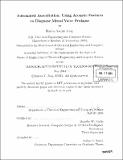Automated auscultation : using acoustic features to diagnose mitral valve prolapse
Author(s)
Jung, Marcia Yeojin, 1982-
DownloadFull printable version (7.815Mb)
Other Contributors
Massachusetts Institute of Technology. Dept. of Electrical Engineering and Computer Science.
Advisor
Dorothy W. Curtis.
Terms of use
Metadata
Show full item recordAbstract
During annual physical examinations, a primary-care physician listens to the heart using a stethoscope to assess the condition of the heart muscle and valves. This process, termed cardiac auscultation, is the primary means of diagnosing cardiac disorders, the most common of which is Mitral Valve Prolapse (MVP). Yet, the practice of auscultation is highly fallible with reports of more than 80% of MVP referrals to cardiologists being unnecessary. The overall goal is to develop an inexpensive, easy-to-deploy software application to detect Mitral Valve Prolapse. Using an electronic stethoscope, audio and EKG data were simultaneously recorded for 51 subjects. The data was then manipulated and a prototypical beat, representative of an individual's pathology, was generated based on Z. Syed's work1. This thesis presents a method for analyzing this prototypical beat. We extract 31 features from the prototypical beat, focusing on systolic activity. We then use the feature set as input to a radial-kernel support vector machine (SVM), which gives a binary classification of the subject as an MVP or non-MVP patient. We support our decision with a visual time-frequency decomposition of a patient's prototypical beat and relevant features. Of the 51 subjects in our test set, we report three false negatives and five false positives. We achieve 82% sensitivity while reducing the false-positive rate to 15%.
Description
Thesis (M. Eng.)--Massachusetts Institute of Technology, Dept. of Electrical Engineering and Computer Science, 2004. Includes bibliographical references (p. 73-75).
Date issued
2004Department
Massachusetts Institute of Technology. Department of Electrical Engineering and Computer SciencePublisher
Massachusetts Institute of Technology
Keywords
Electrical Engineering and Computer Science.